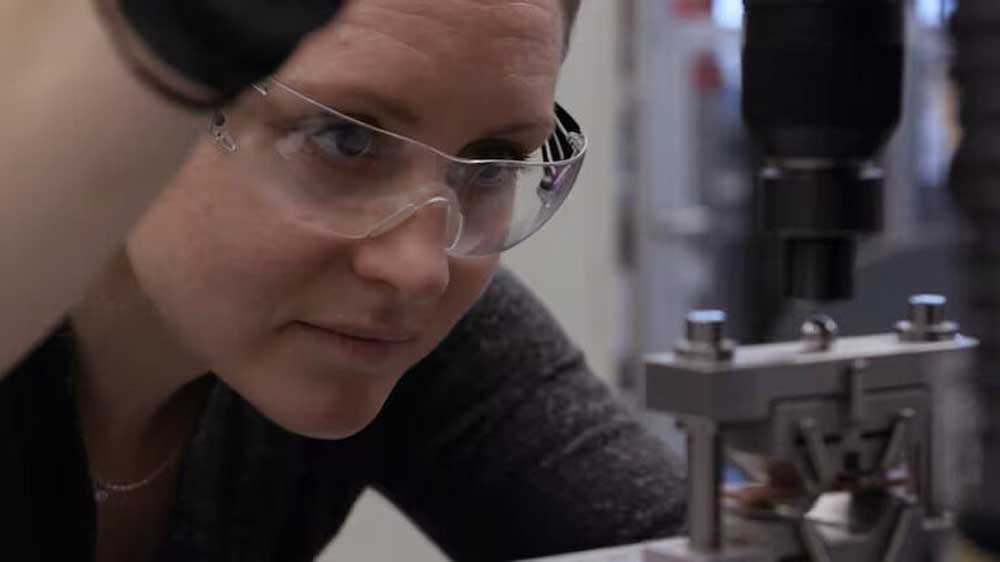Researchers cook up a sweet alternative to single-use plastics
Published 3:51 pm Friday, October 18, 2024

- Boise State University Ph.D. Terra Miller-Cassman tests the mechanical properties of the isomalt-cellulose-sawdust composite in January. Mixing in cellulose and sawdust makes the isomalt less brittle.
For scientist Terra Miller-Cassman, developing a material that could replace single-use plastics is a lot like baking. It includes things like measuring, heating and mixing.
Trending
“I’m a much more precise scientist than I am a baker,” Miller-Cassman, a Boise State University Ph.D., said. “When I bake, I sort of just throw whatever I have into the pan or the oven and see how it comes out. Can’t do that here.”
And the primary ingredient for this project is often used in baking as well. The recipe for Miller-Cassman’s plastic substitute starts with sugar — specifically isomalt.
“We’re always thinking about, ‘What would the starting material be?’ Ideally not a fossil fuel — so plant based,” said Scott Phillips, head of the Macromolecular Sciences Lab at Boise State.
Trending
They landed on isomalt. It’s made from processing sucrose (table sugar), which in the United States, mostly comes from sugar beets.
“You take the beets, you turn that into sucrose, and then you can turn that into isomalt,” Miller-Cassman said.
Most people know of isomalt from baking competitions on TV. It’s used to create delicate glass-like sculptures for cake decorating. It’s technically a sugar alcohol, about half as sweet as table sugar. It’s edible, but eating too much of it will give you a bad stomach.
Isomalt is also used in the movies to make smashable props.
“Whenever you see somebody jumping through a window and it breaks and they’re not cut and they’re not hurt, it’s not because they’re superheroes. It’s because when isomalt breaks, it looks like glass, but it’s not sharp,” Phillips said.
With isomalt as the base, the Idaho researchers have created a new kind of material — one that’s recyclable, reusable and quickly breaks down in the environment.
The plastics problem
Plastic is everywhere around us. And about half of it is designed to be used once and thrown away.
“We’re really dealing with this consume-and-convenience economy that we’re all addicted to, we’re all complicit in it. And it’s really hard to get away from,” said Shannon Jones, plastic reduction coordinator for the Washington State Department of Ecology.
On top of that, less than 10% of the plastic produced is recycled, and when it ends up in the environment, it can stick around for hundreds of years.
“We have more plastics on Earth today than we ever have,” said Jones, who isn’t involved in the isomalt research. “Even if we recycle them, they’re never gone. They’re just down-cycled, effectively, into lesser products and then will eventually have to be disposed of.”
Miller-Cassman has seen the impacts of plastic on the environment firsthand. Before coming back to school, she had a job monitoring plastics pollution in San Diego Bay.
“To be perfectly honest, I got really pissed off because it’s everywhere. And it was a huge problem,” she said. “I got a little tired of just monitoring and creating reports on this problem that didn’t seem to be getting addressed.”
One of the issues with plastics used for single-use products is that their quality is just too good.
“The product that we make from them will last forever … but we throw it away,” Phillips said. “And so the question is, ‘Could we dial back? Could we re-engineer single-use items… (to be) just good enough and last long enough for the application?’ And then you don’t need it to be any better than that.”
A composite
Isomalt is just good enough for single use — but not by itself. Isomalt alone is brittle and would likely shatter on impact if dropped.
So Miller-Cassman looked for something else she could mix in to make the isomalt stronger. Sticking with their plant-based guidelines, she found that cellulose, sawdust and wood flour all imbued favorable properties when mixed in.
“When they’re blended together, they form a tightly bound material called a composite,” she said. “If you find particulates that are compatible with the matrix, then they just help to strengthen the overall resulting material.”
The cellulose and the relatively long strands of wood in the sawdust provided strength against breaking.
The result is a material that’s strong and shatter-resistant. And it only takes a little water to break it down. In the environment, it disappears quickly.
“You could just bury it, and it would become nutrients for the soil,” Phillips said.
The material can be dissolved and reformed into new items without losing strength.
A biodegradable protective coating makes the isomalt mix waterproof long enough for a single use — and it hides the sweet taste.
But what would you use it for?
Miller-Cassman has spent a lot of time in the lab molding the isomalt-sawdust mix into different shapes. She uses an injection molder that melts small pellets of the composite, which she’s colored a rich, earthy green.
“One of the benefits of this project is that everything I work with smells really good,” she said, dropping the green chunks into the hopper. “Smells like melting sugar.”
The sticky viscous goo — the consistency of a slightly chunky toothpaste — is forced into the awaiting mold. The resulting object is a small flower-shaped bowl.
“(The isomalt composite) sort of looks and acts like a ceramic. So you could make little ceramic decorations or food service ware. Things like that, I think, could be incredibly useful, especially from an environmental sustainability perspective,” Miller-Cassman said.
Their aim is to replace plates, cups, forks and spoons, party favors and decorations, basically things that would end up in the landfill after all the cake is gone.









